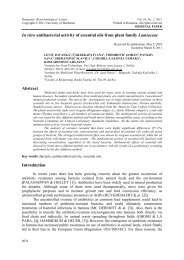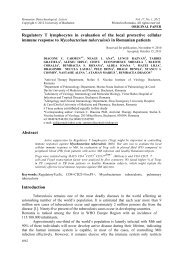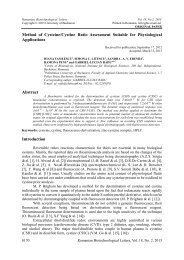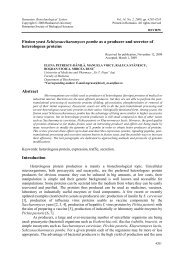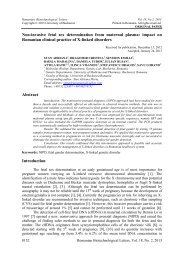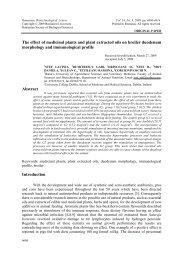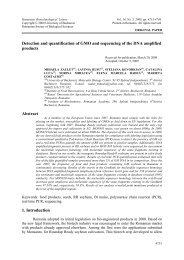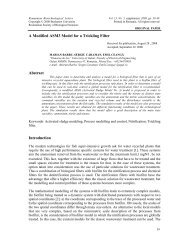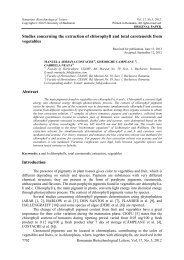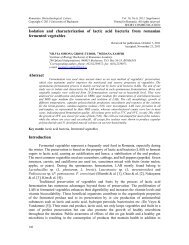The use of RAPD and ISSR markers for genetic ... - Rombio.eu
The use of RAPD and ISSR markers for genetic ... - Rombio.eu
The use of RAPD and ISSR markers for genetic ... - Rombio.eu
Create successful ePaper yourself
Turn your PDF publications into a flip-book with our unique Google optimized e-Paper software.
VELICEVICI GIANCARLA, MADOŞĂ EMILIAN, ŞUMĂLAN RADU,<br />
CIULCA SORIN,POPESCU SORINA, PETOLESCU CERASELA<br />
high degree <strong>of</strong> <strong>genetic</strong> relationship among the different varieties, <strong>and</strong> the high degree <strong>of</strong><br />
polymorphism within barley varieties.<br />
Molecular <strong>markers</strong> had been proved to be valuable tools in the characterization <strong>and</strong><br />
evaluation <strong>of</strong> <strong>genetic</strong> diversity within <strong>and</strong> between species <strong>and</strong> populations. <strong>The</strong> advent <strong>of</strong> the<br />
polymerase chain reaction (PCR) favored the development <strong>of</strong> different molecular techniques<br />
such as r<strong>and</strong>om amplified <strong>of</strong> polymorphic DNA (<strong>RAPD</strong>) [1,31], simple sequence repeats<br />
(SSR or microsatellite) [17], the sequence-tagged sites (STS), r<strong>and</strong>om amplified microsatellite<br />
polymorphism (RAMP), <strong>and</strong> inter-simple sequence repeat polymorphic DNA (<strong>ISSR</strong>) [24 ].<br />
Those molecular <strong>markers</strong> had been <strong>use</strong>d in barley <strong>for</strong> detecting <strong>genetic</strong> diversity (Ciulca,<br />
2010), genotype identification, <strong>and</strong> <strong>genetic</strong> mapping [10, 17, 27].<br />
Genetic analysis with <strong>RAPD</strong> <strong>markers</strong> is relatively easy, fast <strong>and</strong> efficient, there<strong>for</strong>e it<br />
has been extensively <strong>use</strong>d to determine <strong>genetic</strong> diversity among barley varieties <strong>and</strong> to<br />
identify the best quality ones <strong>for</strong> malting [9, 10, 27]. Nevertheless, there are few studies about<br />
<strong>genetic</strong> characterization <strong>of</strong> hull-less barley [32]. Determination <strong>of</strong> <strong>genetic</strong> variability among<br />
genotypes is <strong>use</strong>ful <strong>for</strong> both practical applications in a breeding program <strong>and</strong> cultivar<br />
protection. A variety <strong>of</strong> approaches, from morphological data to molecular <strong>markers</strong> including<br />
<strong>RAPD</strong> [4, 13, 33], AFLP [1], SSR [14, 15 ] <strong>and</strong> <strong>ISSR</strong> [13, 22 ] <strong>markers</strong> have been applied <strong>for</strong><br />
assessment <strong>of</strong> <strong>genetic</strong> variability among genotypes.<br />
<strong>ISSR</strong> <strong>markers</strong>, which involve PCR amplifications <strong>of</strong> DNA using a primer, composed<br />
<strong>of</strong> a microsatellite sequence anchored at 3′ or 5′ end by 2–4 arbitrary, could be <strong>use</strong>d to assess<br />
<strong>genetic</strong> diversity [28]. <strong>ISSR</strong>s had been <strong>use</strong>d <strong>for</strong> cultivar identification <strong>for</strong> potatoes [23], wheat<br />
[21], bean [18], <strong>and</strong> barley [10, 26]. <strong>The</strong> underst<strong>and</strong>ing <strong>and</strong> knowledge <strong>of</strong> <strong>genetic</strong> variation<br />
<strong>and</strong> <strong>genetic</strong> similarities present within individuals or populations are <strong>use</strong>ful <strong>for</strong> the efficient<br />
<strong>use</strong> <strong>of</strong> <strong>genetic</strong> resources in a breeding program. <strong>The</strong> breeder can <strong>use</strong> the <strong>genetic</strong> similarity<br />
in<strong>for</strong>mation to complement phenotypic in<strong>for</strong>mation in the development <strong>of</strong> breeding<br />
populations [11].<br />
In this study, we evaluated <strong>genetic</strong> diversity using <strong>RAPD</strong> <strong>and</strong> <strong>ISSR</strong> <strong>markers</strong>, in order<br />
to establish a base line to assist future conservation <strong>and</strong> breeding programs <strong>of</strong> this species.<br />
Also we aimed to report the <strong>use</strong>fulness <strong>of</strong> <strong>RAPD</strong> <strong>and</strong> <strong>ISSR</strong> <strong>for</strong> the assessment <strong>of</strong> <strong>genetic</strong><br />
diversity.<br />
Materials <strong>and</strong> methods<br />
Plant material. Ten leaves from each <strong>of</strong> the 19 cultivars were collected separately <strong>and</strong> stored<br />
immediately at-80 o <strong>for</strong> DNA extraction. <strong>The</strong> cultivars numbers <strong>and</strong> country <strong>of</strong> origin are listed<br />
in (Tab.1).<br />
Table 1. Studied barley cultivars <strong>and</strong> their geographical origins<br />
code. Genotypes Locatian code. Genotypes Location<br />
1 Orizont Romania 11 Plaisant Hungary<br />
2 Dana Romania 12 Tas Hungary<br />
3 Precoce Romania 13 Secura Austria<br />
4 Adi Romania 14 Dina Germany<br />
5 Mădălin Romania 15 DH19/1 Romania<br />
6 Andrei Romania 16 DH 254/10 Romania<br />
7 Regal Romania 17 DH 260/18 Romania<br />
8 Compact Romania 18 DH 260/12 Romania<br />
9 Gerbel Germany 19 DH 261/22 Romania<br />
10 Lyric France<br />
7494 Romanian Biotechnological Letters, Vol. 17, No. 4, 2012



